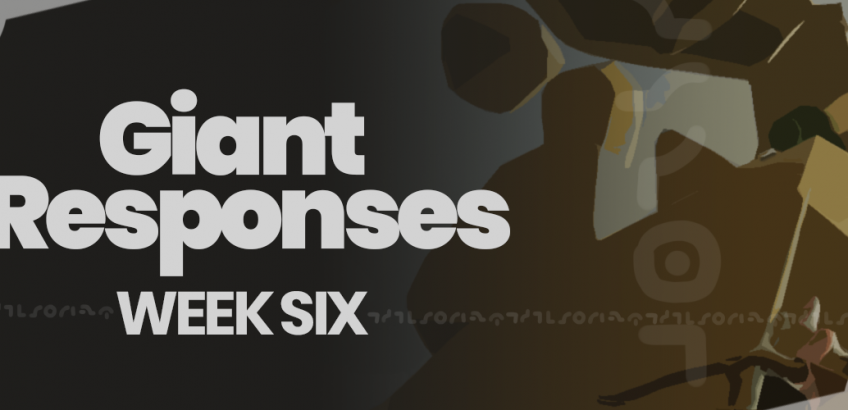
Week 6 – Giant Responses
This week saw us addressing a lot of the insight gained during playtesting while starting to tackle the next question. However, what we attempted to fix and adjust took a bit more time than expected so we governed next week to be wholly dedicated to question-tackling.
In the meantime, here’s what was adjusted/changed this week!
Changes / Playtesting
A major thing we noticed was being able to put your hands through the LSE’s “body”. This was quickly fixed in order to keep the sense of realism and immersion stronger.
A top moment of frustration for many playtesters revolved around the hookshots. Constantly grabbing them from your waist, while cool in theory and seen in other VR titles, seemed to be more difficult than anticipated, especially when the players wanted to do some quicker shots and movements. In addition, teaching to grab a weapon from your waist proved to drastically increase the learning curve and led to a handful of situations we did not predict. A prime example of one such hiccup was if the player somehow grabbed the hookshot on their right side with their left hand. If this occurs, they would be unable to grab a hookshot with their right hand until the left was dropped. All in all, it ended up being confusing, problematic, and not an issue we wanted to get in the way of the experience. Now, the hookshots are always attached to your hands at the wrists so you could shoot when you want as well as climb with them.
Specific climbing routes are also starting to be designed and implemented. Previously, we tested out being able to climb anywhere on the LSE. This proved tough for a variety of reasons, but ultimately we wanted to test out different designs and techniques to guide the player. In our newest build, the routes are white boxed to test out distances and vantage points and have so far proven a welcome addition.
Data collection on top of our playtesting paperwork is also in place! In this way, we will able to record the player’s experience and see where the player went as they traversed the LSE as well as generate heat maps. This is a huge boon for us going forward and well worth the time, as we have been doing more and more playtesting.
Speaking of playtesting, we were graced with the presence of students from The Ellis School, and a handful of them played our newest build. In addition, we had just enough time to ask them some questions (but not go through the whole gamut of the playtest questionnaire). More specifically, we asked about the difficulty of the experience, as that was a number we were determined to lower. Our previous iteration’s difficulty averaged at 5.9 (out of 7). The students let us know that as they started, the difficulty was around a 4 or 5, but once they got used to the controllers (none of them have used Valve Index controllers before) the difficulty drastically lowered to an average of 2.5. More playtesting will need to be done, of course, but this was still great to hear!
Just so you can see the changes as well, here’s our newest iteration:
Question of the Week (and for next week):
What is the correct behavior for the LSE reacting to the Player?
This element of the LSE is one that we knew we had to have, and one that was hotly discussed during playtesting. To no one’s surprise, players wanted to feel the sense that they were taking down something that was not just big and daunting, but living. That is, it would react to your presence and respond in kind.
Meetings and brainstorming ensued, and we landed on three main responses and when they would/could occur
1. Shaking
Having the LSE attempt to shake you off would add more movement and add an interesting feral feel to the LSE. This response would occur if the player is on or above the waist or on the head.
2. Stomping
This seemed like an extremely natural response, as humans will stomp unwelcome insects all the time. To the LSE, the same relationship would seem to apply. This response would occur if the player is on the ground.
3. Idle looking
If the LSE is actively trying to get you, then it seems logical that it would look around for you. While also adding some more movement into the mix, this response gives the LSE a bit more life and agency. This response would occur periodically whenever the player is on the LSE at any time.
Other aspects we plan on working in next week include the following:
- The LSE will always walk towards the player.
- The roar sound effect would be a major signifier of an incoming attack and/or response.
- Multiple weak points/routes
- Damage/respawning
Given the fact that the LSE is now an active participant in the fight, we will be experimenting with the potential of taking “damage” and respawning at a specific point. This would not reset the weak points already destroyed by the player, so the only downside would be that they have to scale the LSE yet again. Taking damage or being hit by the LSE led to an interesting question that bubbled up during our meeting: “How would being knocked away by the LSE feel?”
Perhaps this is yet another question for another week.
Stay tuned next week when we dive into making the LSE come alive and actively try to hunt you down!